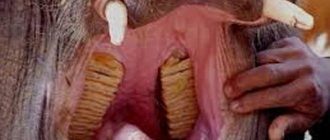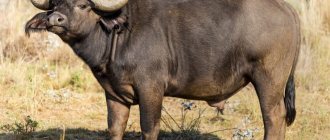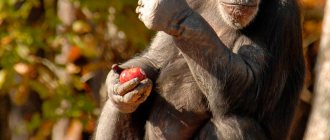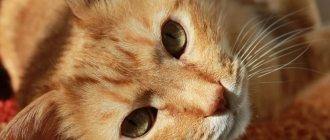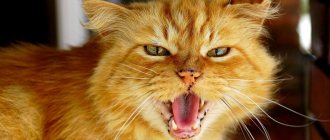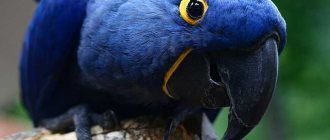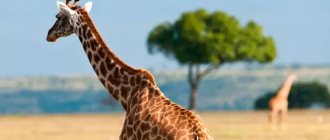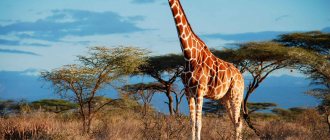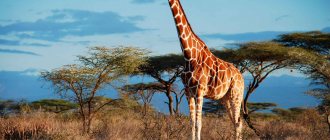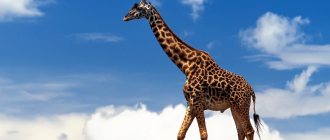- Wild animals
- >>
- Mammals
The giraffe is the tallest land animal.
Many have only seen them in pictures and cannot even imagine how amazing this animal is in real life. After all, it is not only its height that distinguishes it from other animals, but also many other features. The giraffe's head is unlike anyone else's: erect ears, blunt short horns, sometimes as many as five, black eyelashes around huge eyes, and the tongue is absolutely striking in its length, color and shape. Not every zoo has giraffes, and if there are, their enclosures usually go down to some depth, or occupy a couple of tiers, so that you can see the whole animal.
Its giraffes are only peaceful herbivores, but they also treat people absolutely calmly. But people, in turn, in ancient times actively hunted giraffes. Man has found many uses for everyday life from giraffe skin, its tendons and even its tail. But this killed a huge number of individuals, and now they approach giraffe hunting more wisely.
Origin of the species and description
Photo: Giraffe
It is difficult to imagine the origin of giraffes from any animal, they are very specific. But experts believe that they appeared about 20 million years ago from ungulates, most likely from deer. The homeland of these animals is considered to be both Asia and Africa. It is possible that after the appearance of giraffes in Central Asia, they quickly spread across Europe and came to Africa. Now it is difficult to imagine a giraffe anywhere other than the African savannas.
However, the oldest discovered remains of living giraffes are about 1.5 million years old and were found in Israel and Africa. Perhaps this is only one species that survived to this time. Most giraffe species are believed to be extinct. Scientists recreate a picture of the past, where, in their opinion, there were both taller and more massive giraffes, and this was not limited to the giraffe family itself, it’s just that later almost all of them became extinct and only one genus remained.
Actually, the giraffe, as a species, belongs to mammals, the order of artiodactyls, the family of giraffidae. After the giraffe species was isolated back in the 18th century, science developed greatly.
When studying the genetic material of individuals living in different territories, some subspecies were identified:
- Nubian;
- West African;
- Central African;
- Reticulate;
- Unandian;
- Maasai;
- Angolan;
- Tornicroyta giraffe;
- South African.
They all differ in the territory they occupy and slightly in their pattern. Scientists argue that subspecies can interbreed - therefore the division is not of particular importance and exists to divide habitats. Experts also note that there are no two giraffes with the same color scheme, and the body pattern of spots is like the animal’s passport.
Giraffe height and weight
The growth of a giraffe can reach 6 meters, two of which will fall on the neck, famous for its length. Weight ranges from 500 kg to two tons, for comparison we can cite a passenger car, the weight of which rarely reaches at least 1500 kg, which means that an adult giraffe is two cars. To maintain such dimensions, the animal has to eat more than fifty kg of food daily and drink ten liters of water. The giant's heart weighs on average 10-12 kg, and its valves move more than 50 liters of blood per minute. The pressure in the vessels is three to four times higher than human pressure, which is why even a sharp turn of the head can lead to disastrous consequences.
Appearance and features
Photo: Animal giraffe
The giraffe is the tallest animal in the world, its height reaches seven meters, males are slightly taller than females. And also the fourth largest of the land animals, the maximum weight of giraffes reaches two tons, only the elephant, hippopotamus and rhinoceros have more.
The giraffe is famous for its long neck, topped by a disproportionately small head. On the other hand, from below, the neck merges with the sloping body of the giraffe and ends in a long, up to one meter, tail with a tassel. The giraffe's legs are also very long and take up a third of the total height. They are thin and graceful, like antelopes, only longer.
Surprisingly, despite the enormous length of the neck, which averages one and a half meters, giraffes, like all mammals, have only 7 cervical vertebrae. In order to work at such a length, they are elongated in the animal, and the first thoracic vertebra is also elongated. The animal's head is elongated, miniature and neat. The eyes are quite large and black, framed around with thick dark hard eyelashes. The nostrils are very prominent and large. Giraffes' tongue is very long, dark purple, sometimes brown, and looks like a round, very flexible cord. The ears are erect, small, narrow.
Video: Giraffe
Between the ears there are small horns in the form of two columns, covered with skin and wool. Between these two horns, a small middle horn is sometimes visible, and it is more developed in males. Sometimes there are two more horns in the occipital part; they are called posterior or occipital. These giraffes are called five-horned giraffes, and, as a rule, they are all males.
The older the giraffe, the more horns it has. With age, other bony outgrowths may form on the skull, and from them you can even determine the approximate age of an individual. The cardiovascular system of giraffes is interesting. It is special because the heart must cope with pumping blood to great heights. And when lowering their heads, so that the pressure does not exceed the norm, giraffes have vascular clots in the back of the head, which take the entire blow and smooth out changes in blood pressure.
A giraffe's heart weighs more than 10 kg. This is the largest heart among mammals. Its diameter is about half a meter, and the muscular walls are six centimeters thick. Giraffes have short, dense fur. On a more or less light background, there are brownish-red spots of various asymmetrical, irregular, but isometric shapes. Newborn giraffes are lighter than adults; they darken with age. Light colored adults are very rare.
Miracles of evolution using the example of the giraffe
Writes David P. Barash, an evolutionary biologist and professor of psychology at the University of Washington: I first saw a giraffe in its natural habitat in Arusha National Park in Tanzania, and was amazed by the yellow-brown head gliding gracefully at a seemingly impossible height above the tops of the tall trees. acacia That was 11 years ago, which is roughly why the giraffe remains one of my favorite animals. But the giraffe is dear to me not only because of my African impressions.
As an evolutionary biologist and professor, I brought Giraffa camelopardalis on stage during class—not literally—as an example of how natural selection had produced a creature that was, on the one hand, impressively adapted to its peculiar ecological niche, and, on the other hand, is an example of the "clumsy, wasteful and inept" process of evolution, to use Darwin's words. It is sometimes suggested that these oversights are the result of mutations or evolutionary errors. But they actually arise because of history: the fact that at any point in history natural selection has no choice but to work with what is already there. More clearly than other animals, giraffes reflect the fact that organisms were not created from scratch (or if they were, then the Great Creator was very inept). Rather, they were cobbled together through trial and error from their historical predecessors.
Giraffes have long held a special place in the hearts of evolutionists, but for a different reason: as an example of how to distinguish Darwinian evolution from Lamarckian evolution. However, it turns out that the story is not so simple; indeed, nothing at all concerning these amazing and strange animals is simple. A closer look at their private lives has cast mating under suspicion, along with chewing, when it comes to their remarkable anatomy, raising questions that have fueled debate among today's (admittedly small) giraffology community.
Let's start with the most obvious. The giraffe's high stature creates a number of difficulties that have been solved with the help of remarkable adaptations. Pumping blood two meters above the heart to the animal's towering head requires exceptionally high pressure, three times the systolic level in humans. To prevent their arteries from bursting, giraffes require special support structures within their blood vessels.
In another direction, to prevent blood from pooling in the feet, which are at the end of very long legs, giraffes have evolved a type of compression stocking that humans use after surgery or to prevent deep vein thrombosis during long flights. The idea of giraffes is the highly elastic walls of blood vessels in combination with an extensive capillary network. By reducing the perfusion of fluid into surrounding tissues, these designs keep the giraffe's blood in the vessels where it belongs, and not in the surrounding tissues. These animals have another specially adapted compression system in the neck that prevents too much blood from rushing to the head when they bend over to drink - which they don't do very often since they get most of their water from the leaves they eat using their very flexible 45 cm tongues.
Although giraffes' necks are exceptionally long, they are actually inferior to their legs because those colossal necks are - believe it or not - too short. In order to reach the puddle, the drinking giraffe has to spread its legs wide apart. And, by the way, the same mechanism for controlling the flow of fluids works in the opposite direction in the giraffe's neck, when the giraffe stops drinking and raises its head up, allowing a relatively small trickle of blood to flow down so that brain hypoxia does not occur.
The name "giraffe" comes from the Arabic word "zarafah", meaning "fast walker", and giraffes do use their long legs to walk quickly, although their long lever legs and slightly swaying, vertically balanced neck columns seem to that they are moving slowly. For unclear reasons, but presumably due to truly giraffe-like biomechanics, when giraffes need to move quickly, they do not gallop or jump like almost all other quadrupeds, which in such cases lift both their front and hind legs off the ground. Instead, they lift their front and back legs on the same side at the same time, alternating between left and right—rather than back and front—in a manner called “ambling.” It's actually very effective and elegant, more clunky than clunky once the observer gets used to the novelty. (By the way, camels also amble, which perhaps explains the giraffe's Latin name camelopardali, due to the ancient belief that giraffes are half-camel, half-leopard, the latter due to giraffes' noticeably spotted and tile-like coloring .)
Now about that remarkable neck. How many bones are there in a giraffe's neck? Answer: seven (eight, according to a 1999 Journal of Zoology study), the same number as a human's, only the giraffe is huge, and each cervical vertebrae is on average 25 centimeters long. What about the mouse? Also seven, although - surprise - all very small. Mouse.
Detailed photo of a giraffe's neck. Photo: Mike Taylor and Matt Wedel
Probably the most well-known fact about the giraffe's neck (at least among biologists) is the peculiarity of its nerves, in particular the left recurrent laryngeal nerve, which sends impulses to the animal's larynx. Forget for a moment that giraffes are probably the quietest of the large mammals, making sounds, albeit faintly. No one knows why they are so insinuating, although it is clear that their larynx has the same basic innervation as other, noisier mammals, although the impulse travels a longer distance. Perhaps it has something to do with their long neck, or they simply have nothing to say. In any case, the muscles of their larynx - like ours - are stimulated by their laryngeal nerve, and here we have one of the most stunning examples of extremely foolish design in zoology.
The laryngeal nerves, commonly present in vertebrates, branch from the larger vagus nerve, which plays a large role in the parasympathetic system of vertebrates, which sends signals to all major internal organs, including the heart and digestive system. In all mammals, the recurrent laryngeal nerves branch from the vagus nerve at the level of the aortic arch, where the aorta—originally ascending from the heart with the carotid arteries branching from it to supply the neck and head—dives back to supply blood to the rest of the body. The aortic arch makes a 180-degree loop, which is not a problem for the right recurrent laryngeal nerve, which is on the "right" side, avoids the bend of the aorta and goes straight to the larynx along the trachea. However, its left companion has to bend around the aortic arch from below before heading towards the larynx. This is a little anatomically awkward, but is not a big problem for most vertebrates, including humans, since this bend only adds a few centimeters to the path.
This is both an interesting dilemma for long-necked animals and a clear example of evolution. Among modern fish and presumably the fish ancestors of modern mammals, the recurrent laryngeal nerves (left and right) ran in a straight line from the brain to the gills along the heart. In short-necked early mammals, everything was almost the same, only the left branch, passing under the bending part of the aortic arch, was slightly longer and more curved. But in those creatures that evolved to have long necks, the poor left recurrent laryngeal nerve had to take a truly absurd detour during embryonic development: exit the brain, head down to pass under that ever-retracting aortic arch, then head up again to eventually reach the larynx.
In the case of giraffes, this incongruous adaptation now requires a nerve 4.5 m long (2.3 m one way, then back), although if it ran in a straight line, the entire length would be 15 cm. Where does this strangeness come from? Because giraffes evolved from their direct ancestors, who in turn evolved from theirs, and so on to the common ancestor, the fish, the length of the recurrent laryngeal nerves of which was completely reasonable. (And by the way, don't waste all your pity on giraffes: There were other vertebrate descendants of fish - notably sauropod dinosaurs - whose 13.7-meter necks required much longer nerves: approximately 27.5 meters! In a recent technical report - in journal Acta Palaeontological Polinica, to be precise - this absurdity was called a "monument of inefficiency."
It's all very awkward so far. But why did modern giraffes develop such problematic long necks in the first place? Here giraffes help us distinguish Darwinian evolution from Lamarckian evolution. Lamarck believed that giraffes' necks became long because their ancestors stretched theirs. According to Darwin, early giraffes differed from each other in the length of their necks, and those with longer ones reproduced more successfully. According to Lamarck's concept of "inheritance of acquired characteristics"—not very different from "use it or throw it away"—organs grow larger when they are used and shrink when they are not. Almost everyone agrees that early giraffes had necks that were not very different from the necks of other ungulates.
But Lamarck and his followers imagined that these giraffes reached for ever taller leaves on the tops of savanna trees (and giraffes do indeed feed from branches), and their necks lengthened, just as muscles grow with use, until their descendants acquired the longest necks . Darwin's view is slightly different, and more accurate: with increased competition for leafy vegetation, early giraffes with slightly longer necks were able to feed themselves slightly better by reaching for high-growing leaves.
Therefore, they produced more offspring, whose necks, in turn, became longer than those of their parents. Therefore, natural selection favored longer necks, as well as necessary adaptations such as the ability to generate and withstand very high blood pressure while preventing blood from draining into the legs, plus inevitable disadvantages such as the tortuous path of the left recurrent laryngeal nerve.
But the story doesn't end there. There is another competing explanation for why giraffes have such long necks, and it involves sexual selection. First, a small digression. Although many people believe otherwise, there is no fundamental difference between natural selection and sexual selection. Natural selection occurs whenever differential reproduction occurs, in which certain genes are more successful in passing on copies of themselves to future generations. Sexual selection involves competition to obtain and acquire mates, and is as natural as other forms of selection such as foraging for food, avoiding predators, sleeping when tired, or scratching when itchy. It is simply that sexual selection sometimes results in traits—the classic example being the peacock's tail—that are ecologically disadvantageous but are nonetheless positively selected because their overall contribution to fitness through competition with one's own sex or attraction of the opposite sex is greater than the direct losses. concerning simply survival.
It turns out that male giraffes are more vicious than affectionate: during the rut, they fight using their heavy, strong heads attached to long flexible necks - it turns out something like a medieval morning star or flail. And the longer the neck, the more powerful the blows. Therefore, the hypothesis - known as the "mating neck" hypothesis - is that long necks were selected because they helped males win fights with each other. Also, females may have preferred longer-necked males, in part because their offspring would then have longer necks. Accordingly, new males would compete more successfully with other males and be more sexually attractive to females of their generation. One way or another, the male genes for neck length and the female genes for choosing longer-necked mates would have been passed on. This is a variant of what behavioral ecologists call the "sexual progeny hypothesis," which also applies to the evolution of peacocks' tails and other seemingly odd male traits. According to this hypothesis, long necks in female giraffes are a concomitant effect of sexual selection among males.
This is a controversial idea, and the last word has not yet been said. Supporting the "mating necks" hypothesis is the discovery that males with longer necks are actually more successful in combat with each other and, furthermore, giraffes actually prefer longer necks in potential mates, giving another meaning to the term necking. “kissing a clothed partner on the neck” - note New about). Additionally, most of giraffes' foraging occurs at shoulder level rather than at neck level. In addition, giraffes are two meters taller than other leaf-eating animals, suggesting that foraging competition is not the main driving force behind altitudinal evolution. On the other hand, it may be that in times of food shortage the extra growth is worthwhile, and what's more, usually the most nutritious parts of a plant's foliage are found at the very top, in the growing tips.
However, there is no reason to think that success in foraging and success in sex are mutually exclusive in their possible evolutionary influence. This perspective is yet another example of how these lanky, long-legged, long-necked giants embody the diversity of life carved out by evolution. At the same time, it can be difficult to imagine a creature as incredible as a giraffe having sex at all, let alone that they were shaped by it. But the same is true for thinking about sex between our parents, and yet the fact that we are here suggests that they - like giraffes - did it at least sometimes.
Source
Recommended viewing:
Evolution of cats
“Arms race” in the world of bats: scientists have found interesting evolutionary mechanisms
Coevolution: How the “puppy eye look” appeared, and what the arms race turns animals into after millions of years of competition
Where does the giraffe live?
Photo: African giraffes
In ancient times, giraffes inhabited the entire African continent, namely its flat surface. Now giraffes inhabit only some areas of the African continent. They can be found in the eastern and southern countries of the continent, for example, Tanzania, Kenya, Botswana, Ethiopia, Zambia, South Africa, Zimbabwe, Namibia. Very few giraffes are found in central Africa, namely in the states of Niger and Chad.
The usual environment for giraffes is tropical steppes with sparsely growing trees. Water sources are not that important for giraffes, so they can stay away from rivers, lakes and other bodies of water. The localization of giraffe settlement in African territories is associated with their food preferences. For the most part, their numbers prevail in places with their favorite shrubs.
Giraffes can occupy the same territory with other ungulates because they do not share food with them. Giraffes are interested in what grows higher. Therefore, you can observe amazing huge herds of such extraordinary animals as wildebeest, zebras and giraffes. They can stay in one territory for quite a long time, each eating their own food. But in the future they still diverge.
What does a giraffe eat?
Photo: Big giraffe
Giraffes are very long animals; nature itself ordered them to feed on the topmost leaves of trees. In addition, its tongue is also adapted to this: its length is about 50 cm, it is narrow, easily penetrates through sharp spines and captures juicy greens. He can wrap his tongue around a tree branch, pull it closer to him and pluck the leaves with his lips.
The most preferred plant types are:
- Acacia;
- Mimosa;
- Wild apricots.
Giraffes spend almost the entire daylight hours eating. They need to consume up to 30 kg of food per day. Along with the foliage, the required amount of moisture comes in and giraffes can go without water for weeks. Rarely, however, do they go to rivers to drink. They have to spread their legs wide, lower their heads and stay in this position for a long time, quenching their thirst for weeks to come. They can drink up to 40 liters of water at a time.
Giraffes neglect pasture. They can descend to it in the complete absence of their usual food. It is difficult for them to eat grass with their heads down, and they kneel.
Nutrition
The giraffe is artiodactyl, exclusively herbivore. They are ruminants, just like cows, and chew their food several times because they have a four-chambered stomach. The main diet of the animal is leaves of trees and shrubs. Most of all, gourmets prefer acacia. Males choose the highest branches, while they stretch their necks even more and seem even more majestic.
Females do not strive to visually increase their height; they are content with the vegetation that is located at the level of their body. The animals immediately grab the entire branch with their tongue and pull it into their mouth, stripping off all the leaves. In order to feed themselves, giraffes eat up to 20 hours a day, because they need at least 30 kg.
The food they eat is so rich in juices that giraffes have very little need for water. For weeks, or even months, this large animal can go without drinking. When a giraffe drinks, it can drink about 40 liters at once.
There is no such amount of water at the top, so when drinking, the animal is forced to bend its neck very low and spread its front legs wide apart. This is the most uncomfortable and vulnerable position; it is in this position that the giraffe is clumsy and clumsy. Therefore, he starts drinking only in full confidence that there is no danger nearby. By the way, this is why giraffes do not like to nibble grass.
Features of character and lifestyle
Photo: Giraffes in Africa
Giraffes are diurnal animals. Their greatest activity is confined to the early morning and late evening. In the middle of the day it can be extremely hot, and giraffes prefer to rest or stand among tree branches, resting their heads on them. All life passes in leisurely consumption of food and short rest. Giraffes sleep at night, in fits and starts of several minutes. Experts say that the longest and deepest sleep in animals lasts no more than 20 minutes.
Giraffes move very interestingly: they alternately rearrange their front and hind legs in pairs, as if swaying. At the same time, their neck sways very strongly. The design looks shaky and awkward.
Giraffes can communicate with each other at a frequency of 20 Hz. People don’t hear this, but experts have studied the structure of the animal’s larynx and come to the conclusion that when they exhale, they actually make hissing sounds that are audible only to themselves. The lifespan of individuals in the wild is about 25 years. However, in captivity, a much higher age of animals was recorded, namely 39 years.
Subspecies
The distribution by subspecies includes the territorial location of these mammals and the pattern on the body. Today there are nine subspecies of giraffes.
Nubian giraffe
The Nubian giraffe (G. c. camelopardalis) lives in eastern South Sudan and southwestern Ethiopia. Giraffes of this subspecies have distinctive chestnut spots surrounded by mostly white lines. The bone growth on the forehead is more pronounced in males. There are believed to be around 250 giraffes left in the wild, although this figure has not been confirmed. Nubian giraffes are difficult to find in captivity, although a small group is located at the Al Ain Zoo in the United Arab Emirates. In 2003, the group consisted of 14 individuals.
Reticulated giraffe
Reticulated giraffe (G. c. reticulata), also known as the Somali giraffe. Its homeland is northeastern Kenya, southern Ethiopia and Somalia. It has a distinctive pattern on its body, which consists of spiky, reddish-brown polygonal spots separated by a network of thin white lines. The spots may be located below the hock, and a bony growth on the forehead is present only in males. It is estimated that there are a maximum of 5,000 individuals in the wild and about 450 in zoos.
Angolan giraffe
The Angolan giraffe or Namibian giraffe (G. c. angolensis) lives in northern Namibia, southwestern Zambia, Botswana and western Zimbabwe. Genetic research on this subspecies suggests that the desert populations of northern Namibia and Etosha National Park constitute a distinct subspecies. It is characterized by large brown spots on the body with jagged or elongated corners. The patterns are distributed along the entire length of the legs, but are absent in the upper part of the face. The neck and rump have a small number of spots. The subspecies has a white patch of skin in the ear area. According to recent estimates, a maximum of 20,000 animals remain in the wild and about 20 are in zoos.
Giraffe cordo fan
The Kordofan giraffe (G. c. antiquorum) is distributed in southern Chad, the Central African Republic, northern Cameroon and the northeastern part of the Democratic Republic of the Congo. The giraffe population of Cameroon was previously classified as a different subspecies - the West African one, but this was a mistaken opinion. Compared to Nubian giraffes, this subspecies has more uneven spotting. Their spots can be located below the hocks and on the insides of the legs. A bony growth on the forehead is present in males. About 3,000 individuals are thought to live in the wild. Considerable confusion exists regarding the status of this and the West African subspecies in zoos. In 2007, all supposed West African giraffes were in fact Kordofan giraffes. Taking into account these amendments, there are about 65 individuals of Kordofan giraffes in zoos.
Masai giraffe
The Masai giraffe (G. c. tippelskirchi), also known as the Kilimanjar giraffe, lives in central and southern Kenya and Tanzania. This subspecies has its distinctive, irregularly distributed, jagged, star-shaped spots that are found on the legs. Most often, a bone growth on the forehead is found in males. There are about 40,000 giraffes left in the wild, and about 100 giraffes are in zoos.
Rothschild's giraffe
The Rothschild's giraffe (G. c. rothschildi), named after Walter Rothschild, is also known as the Baringo giraffe or Ugandan giraffe. Its range includes parts of Uganda and Kenya. Giraffes of this subspecies have large dark spots that have smooth contours, but also have sharp edges. Dark spots may have lighter lines. The spots rarely extend below the hock and almost never reach the hooves. Fewer than 700 individuals remain in the wild and more than 450 Rothschild's giraffes live in zoos.
South African giraffe
The South African giraffe (G. c. giraffa) lives in northern South Africa, southern Botswana, southern Zimbabwe, and southwestern Mozambique. The subspecies is characterized by the presence of dark, slightly rounded spots on the reddish color of the skin. The spots spread down the legs and become smaller in size. There are approximately 12,000 South African giraffes in the wild and 45 in captivity.
Rhodesian giraffe
The Rhodesian giraffe (G. c. thornicrofti), also called Thornicroft's giraffe, after Harry Scott Thornicroft restricted the Luangwa Valley in eastern Zambia. Has jagged spots and some in the shape of a star, and which sometimes spread to the legs. The bony growth on the forehead of males is underdeveloped. No more than 1,500 individuals remain in the wild.
West African giraffe
The West African giraffe (G. c. peralta), also known as the Niger or Niger subspecies, is endemic to the southwestern part of the Niger Republic. Giraffes of this subspecies have a lighter coat compared to other subspecies. The spots on the body are lobate-shaped and extend below the hock. Males have a well-developed bony growth on the forehead.
This subspecies has the smallest population size, with fewer than 220 individuals remaining in the wild. Cameroon giraffes were previously classified as this subspecies, but in fact, they were Kordofan giraffes. This error led to some confusion in the population estimates of the subspecies, but in 2007 it was determined that all West African giraffes found in European zoos are in fact Kordofan subspecies giraffes.
Social structure and reproduction
Photo: Baby giraffe
Giraffes are herd animals, but rarely live alone for any length of time. One group usually contains no more than 10 - 15 individuals. Within one herd there are dominant males who behave more stately relative to the others; the rest give way to them. There is a fight of heads and necks for the title of chief, the loser remains in the herd in the role of a secondary one, and is never expelled.
The mating season for giraffes occurs during the rainy season, namely in March. If seasonality is not particularly pronounced, then giraffes can mate at any time. Fights between males do not occur at this time; they are very peaceful. Females mate either with the dominant male or with the first one they come across.
The male approaches the female from behind and rubs his head against her, placing his neck on her back. After some time, the female either allows sexual intercourse with her or rejects the male. The female's readiness can be recognized by the smell of her urine.
The gestation period lasts a year and three months, after which one baby is born. During childbirth, the female bends her knees to prevent the baby from falling from a height. The height of a newborn is about two meters and weight up to 50 kg. He is immediately ready to take a vertical position and get acquainted with the herd. Each giraffe in the group comes up and sniffs him, getting to know him.
The lactation period lasts about a year, but the little giraffe begins to taste leaves from trees already from the second week of life. After the mother finishes feeding the baby milk, it may still remain near her for several months. Then, over time, it becomes independent. Females can bear offspring once every 2 years, but usually less frequently. At 3.5 years old, female cubs become sexually mature and can also form relationships with males and give birth to cubs. Males become sexually mature a little later. Giraffes reach their maximum growth at 5 years of age.
Camouflage and protection
In addition, the peculiar coloring of the animal perfectly matches the shadow of the tree, cast on the soil and dotted with spots from the sun's rays passing through the foliage - this increases the animal's ability to hide among its surroundings to an even greater extent.
The giraffe defends itself from attacks by enemies only with strong blows of its front legs, which males also use in collisions with each other; The giraffe is helped to avoid predators by its acute vision and hearing, as well as the high position of its head, which allows it to view the surroundings over an extremely long distance.
Often the giraffe has to flee, and he raises his tail, twisted in a helical shape, above his back and tilts his neck slightly forward; his running is extremely peculiar and resembles a clumsy gallop.
When running, the hind legs are spread apart and placed in front of the front legs with each step; from behind it seems as if the animals are rushing without making any movements themselves. Giraffes run so fast that it takes a very good horse to catch up with the animal; nevertheless, giraffes are usually hunted on horseback. Giraffe meat is very tasty, and the skin is valued at 40 to 50 rubles.
Natural enemies of giraffes
Photo: Animal giraffe
Giraffes do not have many enemies; after all, they are large animals that not every predator can defeat. Lions, for example, are able to cope with a giraffe; the animal is afraid of them. In part, giraffes walk with their heads held high and look into the distance in order to see a predator in time and warn the herd about it. Lionesses sneak up on the giraffe from behind and jump on the neck; if they manage to bite through the organs well, the animal quickly dies.
Attacking a giraffe from the front can be dangerous: they defend themselves with their front hooves and can break the skull of a persistent predator with one blow.
Baby giraffes are always at greatest risk. They are defenseless and weak, and also miniature. This makes them vulnerable to many more predators than adults. Leopards, cheetahs, and hyenas hunt the cubs. Having strayed from the herd, the cub will absolutely become the prey of one of them.
The most dangerous predator for the giraffe is man. Why didn’t people kill these animals! This is the extraction of meat, skins, tendons, tails with tassels, and horns. All of this had unique uses. It is worth noting that when killing a giraffe, a person used all its components. Drums were covered with leather, tendons were used for strings and stringed musical instruments, meat was eaten, tail tassels were used for fly swatters, and the tails themselves were used for bracelets. But then people appeared who killed giraffes just for fun - this greatly reduced the number of individuals to date.
Communication and perception
Giraffes rarely make sounds and are therefore considered quiet or even mute mammals. They communicate with their own kind using infrasound. Sometimes they can make sounds similar to grunting or whistling. When alarmed, a giraffe can snort or grunt, thereby warning neighboring giraffes of danger. Mothers whistle to their calves. In addition, females search for lost cubs using roars. Calves respond to their mothers by bleating or meowing. During courtship, males may make coughing sounds. The giraffe has good visibility due to its height. This allows the animals to maintain continuous visual contact even at great distances from the herd. Keen vision helps the giraffe see a predator from a distance in order to prepare for an attack.

